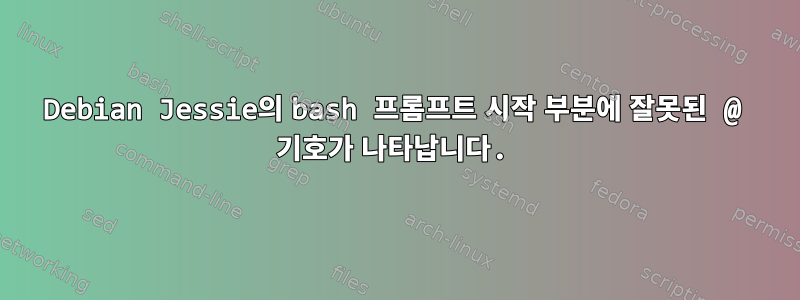
최근에 이것을 달성하기 위해 의도적으로 아무것도 하지 않은 채 Bash 프롬프트가 표시되었습니다.표지판에(즉, @) 그 앞에 놓는다. 이전에는 이런 일이 발생하지 않았습니다. 또한 내 안에는 ~/.bashrc이런 일이 일어나야 할 것 같은 어떤 것도 보이지 않습니다 .
이것은 GNU Bash를 사용하는 Debian Jessie GNU/Linux에서 작성되었습니다.
예를 들어 현재 Bash 세션은 다음과 같습니다.
@sampablokuper@debianbox:~$ python3
Python 3.4.2 (default, Oct 8 2014, 13:14:40)
[GCC 4.9.1] on linux
Type "help", "copyright", "credits" or "license" for more information.
@>>> 1+2
3
@>>> exit()
@sampablokuper@debianbox:~$
그리고 처음에는 다음과 같았습니다.
sampablokuper@debianbox:~$ python3
Python 3.4.2 (default, Oct 8 2014, 13:14:40)
[GCC 4.9.1] on linux
Type "help", "copyright", "credits" or "license" for more information.
>>> 1+2
3
>>> exit()
sampablokuper@debianbox:~$
~/.bashrc내 Bash 프롬프트 관련 줄은 모두 다음과 같습니다.
# set variable identifying the chroot you work in (used in the prompt below)
if [ -z "${debian_chroot:-}" ] && [ -r /etc/debian_chroot ]; then
debian_chroot=$(cat /etc/debian_chroot)
fi
# set a fancy prompt (non-color, unless we know we "want" color)
case "$TERM" in
xterm-color) color_prompt=yes;;
esac
# uncomment for a colored prompt, if the terminal has the capability; turned
# off by default to not distract the user: the focus in a terminal window
# should be on the output of commands, not on the prompt
#force_color_prompt=yes
if [ -n "$force_color_prompt" ]; then
if [ -x /usr/bin/tput ] && tput setaf 1 >&/dev/null; then
# We have color support; assume it's compliant with Ecma-48
# (ISO/IEC-6429). (Lack of such support is extremely rare, and such
# a case would tend to support setf rather than setaf.)
color_prompt=yes
else
color_prompt=
fi
fi
if [ "$color_prompt" = yes ]; then
PS1='${debian_chroot:+($debian_chroot)}\[\033[01;32m\]\u@\h\[\033[00m\]:\[\033[01;34m\]\w\[\033[00m\]\$ '
else
PS1='${debian_chroot:+($debian_chroot)}\u@\h:\w\$ '
fi
unset color_prompt force_color_prompt
# If this is an xterm set the title to user@host:dir
case "$TERM" in
xterm*|rxvt*)
PS1="\[\e]0;${debian_chroot:+($debian_chroot)}\u@\h: \w\a\]$PS1"
;;
*)
;;
esac
Bash 프롬프트를 원래대로 표시하려면 어떻게 해야 합니까?
답변1
을 기반으로메타 토론,@steeldriver를 아주 잘 복사했습니다.모든 답변여기:
readline활성화하도록 구성한 것 같습니다.편집 모드 표시. ~에서8.3.1 Readline 초기화 파일 구문Bash 참조 매뉴얼의 내용:
show-mode-in-prompt (Off)
If set to On, add a character to the beginning of the prompt
indicating the editing mode: emacs (@), vi command (:) or vi
insertion (+).
다음을 사용하여 현재 셸에서 이를 비활성화할 수 있어야 합니다.
bind 'set show-mode-in-prompt off'
영구적으로 비활성화하려면 설정된 위치( ~/.inputrc또는 ) 를 찾아야 합니다 /etc/inputrc.


